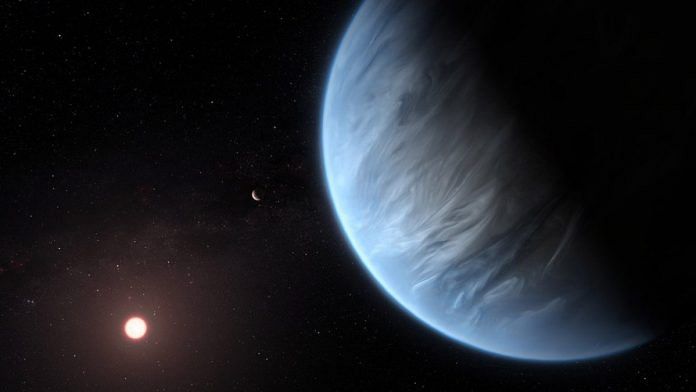Bengaluru: Astronomers using the Hubble Space Telescope have discovered that an exoplanet called K2-18b orbiting the red dwarf star K2-18, 110 light years away, could have water vapour in its atmosphere.
The ‘mini-Neptune’ is 7.96 to 8.6 times the mass and 2.24 to 2.7 times the radius of Earth, and orbits close to its star, finishing one orbit in 33 days.
It is most likely a gaseous planet without a surface, unlike Earth, but is likely to have an entire water cycle where water evaporates and rains down from clouds.
A giant gas planet
The planet possibly lies within the ‘habitable zone’ of its system. However, these findings do not imply potential signs of life or even habitability of the planet. A habitable planet requires liquid water on the surface and K2-18 is most likely a gas giant with a high mass.
However, this find is significant as it demonstrates the ability to identify and detect water vapour — an important tool in our kit to seek out habitable planets in the universe.
Two different teams of astronomers made these findings independently, almost 24 years after the very first exoplanet was discovered. The teams used archive data of transits made by the planet as it went around its star from 2016 and 2017 captured by the NASA/ESA Hubble Space Telescope.
The University College London team published their findings in Nature Astronomy this week while the University of Montreal team uploaded a preprint of their yet-to-be published paper on arXiv.
Detecting water on an exoplanet
Exoplanets are bigger than Earth and are classified as either super-Earths (rocky bodies up to ten times the mass of earth) or mini-Neptunes (gaseous bodies with similar mass). These are the least understood type of planets, especially in terms of composition, and yet the most frequently occurring.
They’re primarily distinguished by what is present in their atmosphere: mini-Neptunes are mainly composed of hydrogen and helium like other gaseous bodies, while super-Earths contain larger compounds such as nitrogen or even carbon dioxide.
The distinction also determines whether a planet could hold life — if there’s no rocky surface, it almost definitely would not.
Determining what’s in the atmosphere requires observation through the transit method — observing the starlight through a planet’s atmosphere when it passes in front of a star.
Different wavelengths of light pass preferentially through this atmosphere based on its composition and thickness, and we can thus deduce what gases are present in it.
The presence of primarily hydrogen and helium seems to suggest that the planet is most probably gaseous and not rocky.
The studies suggest that the hydrological process on K2-18b is similar to that of earth’s deserts: clouds rain down as water and as they fall through the increasingly hot atmosphere, they evaporate before reaching the surface.
On this planet, the atmosphere becomes increasingly warm deeper into the planet.
An exoplanet of oceans?
Observations about the presence of water vapour in a planet’s atmosphere do not indicate the volume of water present. The signature would be the same for trace amounts of vapour and even for large quantities.
The University College London team, lead by Angelos Tsiaras, modeled the amount of water vapour to be anywhere between 0.01% to 50% of the planet’s atmosphere, the latter implying that it is a planet that is covered entirely by an ocean.
This isn’t even the first planet to hold water vapour that has been discovered. NASA announced last year that significant amounts of water vapour was detected in the atmosphere of a Saturn-mass planet, called WASP-39b, 700 light years away.
However, the planet measures scorching temperatures of 776.7 degrees Celsius, and is definitely not hospitable to life, while K2-18b has an average temperature of 1 degrees Celsius.
It sits well within what is defined as the habitable zone of a system. Despite almost certainly not having a rocky surface, its atmosphere could potentially be habitable, just as we speculate the boiling Venus’s top layers of atmosphere could be.
“This is the only planet right now that we know outside the solar system that has the correct temperature to support water, it has an atmosphere, and it has water in it—making this planet the best candidate for habitability that we know right now,” said Tsiaras in a press call before the release of the paper.
Future launches of observatories like NASA’s James Webb Space Telescope in 2021 and European Space Agency’s (ESA) Atmospheric Remote-Sensing Infrared Exoplanet Large-Survey (ARIEL) telescope due to be launched in 2028 could reveal a lot more.
Giovanna Tinetti (UCL CSED), co-author of the Nature Astronomy paper and Principal Investigator for ARIEL, said in a press release: “Our discovery makes K2-18b one of the most interesting targets for future study. Over 4000 exoplanets have been detected but we don’t know much about their composition and nature. By observing a large sample of planets, we hope to reveal secrets about their chemistry, formation and evolution.”
Ethics and conflict
These two studies were also embroiled in conflict with each other.
The UCL astronomers used Hubble data collected by the University of Montreal’s team belonging to the Institute for Research on Exoplanets. The latter had been studying the planet for three years and Hubble data becomes public after one year.
“This is data that we acquired and in some ways we had done all the work,” said Björn Benneke, the lead author of the as yet unpublished pre-print.
“The UCL team decided to just take our data and write their own publication of this. It’s not illegal or anything, but it’s bad practice,” he added.
However, Benneke asserted in the same interview that the fact that two independent teams arrived at similar conclusions points to a strong likelihood of a water cycle on the planet.






